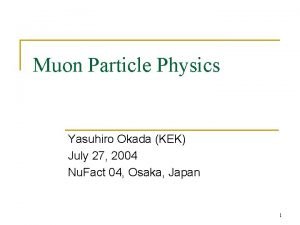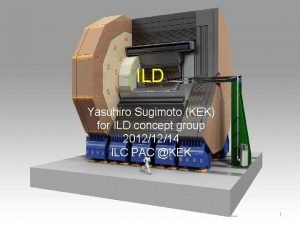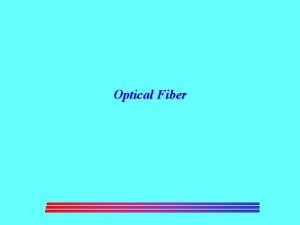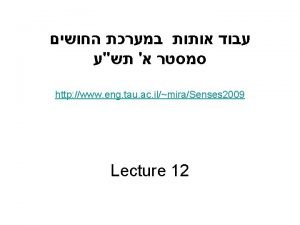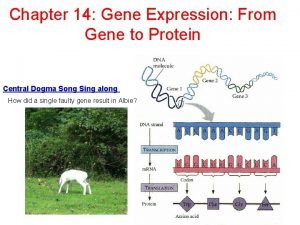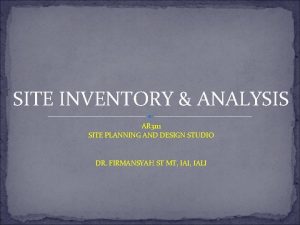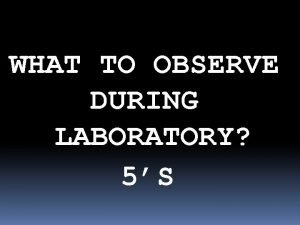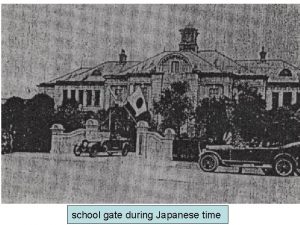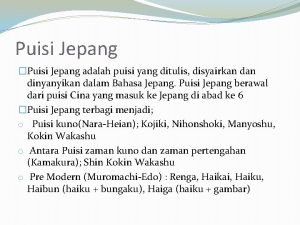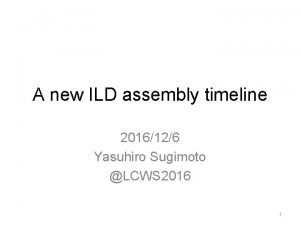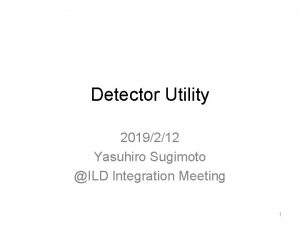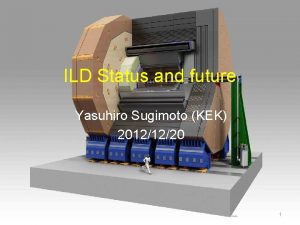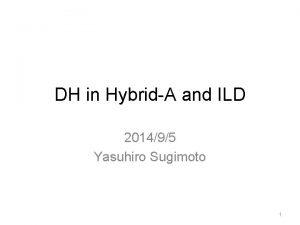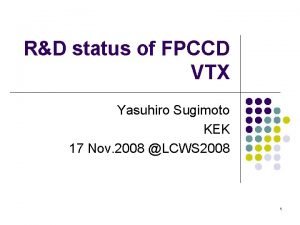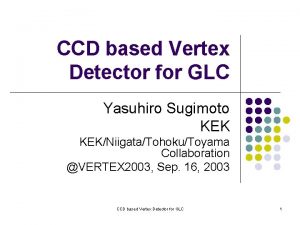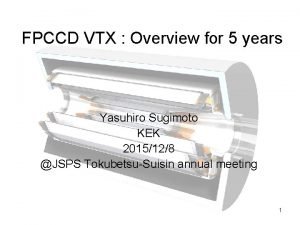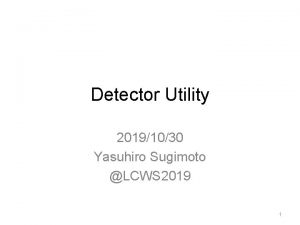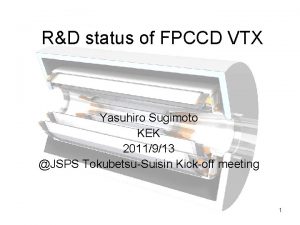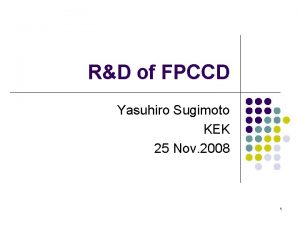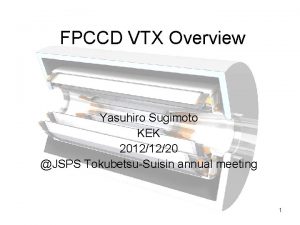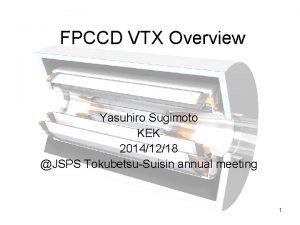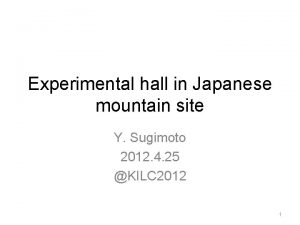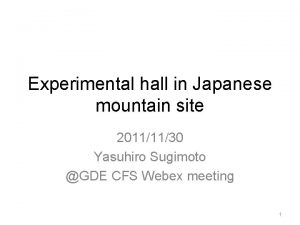ILD in Japanese site Yasuhiro Sugimoto 201221 ILD

































- Slides: 33

ILD in Japanese site Yasuhiro Sugimoto 2012/2/1 ILD integration meeting 1

Japanese candidate sites • Two candidate sites under investigation – Kitakami – Sefuri • Both sites have very good geology of granite 2

Detector hall in Japanese sites • Earth covering depth is quite large: 200~500 m • Therefore, (inclined) horizontal tunnel is used for access instead of vertical shafts • Length of the access tunnel is 1000~1700 m, depending on the detail of the site • In addition to the main cavern, storage caverns and a compressor cavern will be build 3

Storage cavern (small tunnels not shown) Helium compressor / cryogenics Main access tunnel Loading area Detector services 4

Surface Storage caverns are not shown Damping Ring 5

Updated configuration 6

Main cavern • I-shape, 25 m(W)x 110 m(L)x 37 m(H) • Access tunnels from a side wall • Construction adit at the top of the cavern – After construction, it will be used for a duct tunnel and a path of smokes/He gas in emergency • • • Alcoves (7. 5 m depth) at the garage positions Storage caverns (alcoves) at both ends Two sets of 250 ton crane with smaller sub-crane 1 m thick side walls supporting crane rails Floor level is 12. 6 m (=9+2. 2+1. 4) below the beam line 7

Main cavern • Cross section view along the beam line 8

Main cavern • Side wall – garage side (view from inside) 9

Main cavern • Side wall – access tunnel side 10

Detector service area 11

Detector service area 12

Storage cavern • Purpose – Storage of detector pieces before installation – Preparation/storage of tools for detector assembly/installation – Meeting rooms and rest room can be build in this cavern • Size: 15 m(W)x 20 m(D)x 15 m(H) • Connected to the main access tunnel by a small tunnel • ILD storage cavern is connected to the compressor cavern by a small tunnel 13

Storage cavern 14

Compressor cavern • 15 m(W)x 50 m(L)x 11 m(H) • Helium compressor and liquefier for – ILD/Si. D solenoid Common or – QD 0/QF 1 – Crab cavity independent ? Liquefier • Requirements: – 400 k. W electric power – 300 L/min cooling water – 10000 m 3/h air ventilation Compressor • Air compressor for air-pads ? Based on cryogenic system for JPARC 1. 2 k. W 15

Cryogenic system • Helium gas storage tank on surface • Compressor and liquefier in the compressor cavern • 4 K liquid helium system will be designed by accelerator group • “Plug-compatibility” between accelerator group and LOI groups has to be established by Y. Makita 16

ILD Detector assembly • Return yoke – Pre-assembled on surface as relatively small blocks ~200 tons – Each ~200 ton block is carried into the cavern one by one and assembled into one barrel – No gap in the barrel yoke Less leakage field 17

ILD Detector assembly • Solenoid – Chimney for the current lead and tubes locates at the end of the cylinder – Wound, assembled, and tested on surface (Solenoid factory on site) – Coil should be a single piece, rather than 3 modules to reduce space and time – Carried into the cavern as a whole • Surface assembly hall has to be large enough to make yoke blocks and the solenoid (coil and cryostat (inner and outer cylinder)) in parallel 18

ILD Detector assembly 1. 2. 3. 4. 5. 6. 7. 3 Barrel assembly Endcap (+) assembly Endcap (-) assembly Solenoid installation Sub-detectors installation QD 0 support tube (-) assembly QD 0 support tube (+) assembly 4, 5 1 2 6 7 19

Access tunnel ILD Si. D A trailer with lower deck height would reduce the tunnel size 20

Construction period • Construction period is one of the most controversial issues for the shaft-less detector hall • Construction period of an access tunnel (L~1 km) is similar to that of a vertical shaft (f=18 m, d~100 m) • Non-CMS style assembly was once proposed for GLD as “modified CMS assembly” which can be done within the same time period as the CMS style assembly 21

Non-CMS style assembly 22

CMS style assembly 23

Things to do • More considerations and studies on – Safety issues (evacuation of people in emergency) – Vehicles for transportation of heavy elements (gear track? ) – Surface assembly area • Parameters to be specified – Temperature and dew point in the cavern – Requirements for electric power, cooling water, and air conditioning • Estimations to be made – Ventilation speed of smoke/He – Stress and deformation of the cavern with complete design – Cost and construction period 24

Schedule • Define the yoke construction method and tools needed: end of February (? ) • Fix the cavern design: early March • CFS Baseline Technical Review: Mar. 2223 at CERN • Finalize the assembly method: ILDWS in May 25

Backup slides 26

Access tunnel parameters • There are several options for the ILC route and the location of the IP, and the optimization is not done yet • Parameters listed below are just for some examples of the access tunnel to the experimental hall Site Option Length Slope Earth covering* Beam line elevation A 1 1770 m 6. 3% ~300 m 110 m 2 980 m 6. 3% ~200 m 110 m 1 1420 m 7% ~550 m -30 m 2** 1470 m 7% ~400 m -21 m B (*) Vertical distance between the cavern ceiling and the surface These values changes largely with the IP location (**) Main linac is inclined by 0. 03% 27

Tunnel layout examples 28

Access tunnel • Trailer truck for transportation – 225 t/5 axles 450 t with 2 trailers – Capability of ~7% slope • Gear track (Abt system) is also suggested 29

Access tunnel • Crossing with main access tunnel 30

Access tunnel • Crossing with sub access tunnel 31

Safety issues • Ventilation – Smoke and Helium gas will go out through the construction adit connected at the top of the cavern, and will not flow into the access tunnel – Small vertical shaft for GPS alignment may be used for ventilation – Amount of Helium gas ~ 20000 m 3 (CMS: 2 x 250 m 3 x 20 bar =10000 m 3 at 1 bar, x 2 for Si. D+ILD) =25 mx 100 mx 8 m No problem • Escape in emergency – Enough number of electric cars equipped with oxygen masks will effectively take people to the surface 32

Electric cars Mitsubishi TOYOTA Nissan 33
 Yasuhiro okada
Yasuhiro okada Ild nurse
Ild nurse Icd 10 code for seasonal allergies unspecified
Icd 10 code for seasonal allergies unspecified Ild
Ild Ild.deb
Ild.deb Ild vs led
Ild vs led Ild
Ild Hot site cold site warm site disaster recovery
Hot site cold site warm site disaster recovery What is a site and p site of ribosome
What is a site and p site of ribosome Site inventory map
Site inventory map Untangle ipsec vpn setup
Untangle ipsec vpn setup Winter holidays japan
Winter holidays japan Japanese term of sariling kusa
Japanese term of sariling kusa Anime writing style
Anime writing style Shoko hamano
Shoko hamano Is tsunami a japanese word
Is tsunami a japanese word Old food pyramid
Old food pyramid Japanese grammar order
Japanese grammar order Japanese fish story
Japanese fish story Poem 31 syllables
Poem 31 syllables Ta form japanese
Ta form japanese Sushi roulette
Sushi roulette In the japanese game show sushi roulette
In the japanese game show sushi roulette Human academy japanese language school fees
Human academy japanese language school fees Japanese visa photo size
Japanese visa photo size Do all shinigami like apples
Do all shinigami like apples Gate in japanese
Gate in japanese Kouhai kun sakurasou
Kouhai kun sakurasou Of mice and men acrostic poem
Of mice and men acrostic poem The japan foundation sydney
The japan foundation sydney Japanese feudal hierarchy
Japanese feudal hierarchy Contoh puisi jepang dan artinya
Contoh puisi jepang dan artinya Examples of tagalog zarzuela
Examples of tagalog zarzuela Origami made to assume concrete shapes
Origami made to assume concrete shapes
